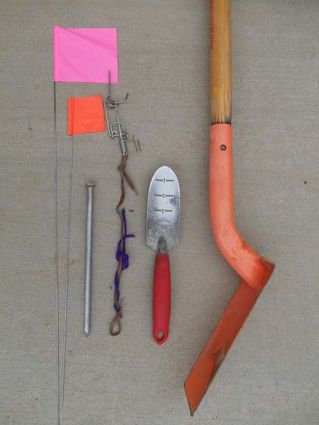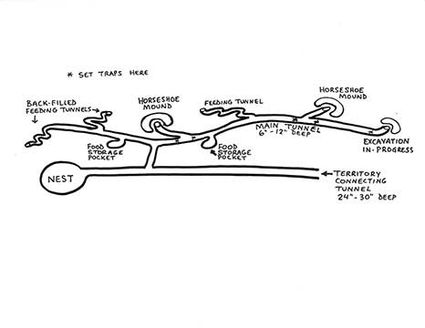Trapping pocket gophers in Tehachapi

My gopher trapping kit. Left to right: Two different colored flags, a spike, wire gopher trap with a tether attached, a narrow trowel, and narrow trenching shovel.
Named after the skin pouches, or "pockets" on the sides of their face used for carrying plant material, Rodentia Geomyidae, or Pocket Gophers live in abundance in the Tehachapi area. Most of the gophers in our area are slightly smaller than the gophers in the San Joaquin Valley, averaging 4 to 6 inches long. Their small beady eyes and long front teeth make it a stretch to call them cute. Gophers are solitary creatures. Except for a mother raising her young or brief breeding encounters they live alone. A female gopher can have as many as 4 litters a year and up to 13 babies per litter although the average litter is closer to 5 or 6. As herbivores, gophers eat over 50% of their body weight in plant material every day. With their long claws they are master excavators digging 7 or 8 tunnels with a diameter of 2 1/2 to 3 1/2 inches that can each be up to 800 ft long. Most tunneling is done in the fall but gophers are active all year long. They are clever about moving dirt around underground by backfilling unused tunnels so their presence is difficult to detect. Obvious signs of gopher activity are horse-shoe shaped mounds of dirt, plants that suddenly wilt or disappear altogether, and small round holes filled with loose soil.
Gophers are responsible for a considerable amount of damage to crops, and landscape plants, but probably more devastating is the damage inflicted on water lines and irrigation systems. Gopher tunnels diverting irrigation water not only waste the water but can result in the loss of unwatered plants before an underground breech can be detected. Even non-gardeners can experience the damaging effects of pocket gophers, with collapsing patio bricks and sinking retaining walls.
Because Pocket Gophers are classified as non-game mammals, farmers, landscapers, home owners, and gardeners are legally allowed to control them at any time by any legal means.
Many predatory and scavenger animals eat gophers. Domestic dogs love to eat them. For this reason I do not like to use poison as a means to control gophers. Live traps and chewing gum just don't work. A very effective method of controlling gophers, using pellets that produce a poisonous gas, was outlawed in California a few years ago. The US Forest Service uses a wire trap called the "Cinch Sure" that gets good reviews. There are many other brands of gopher traps including; Macabee, Gophinator, Black Hole, Red ox and Black Box. Refer to the instructions that come with the trap as the process to set the traps varies.

I currently use a wire trap called a Trapline Standard-Sized Mole Trap which can be obtained at http://www.traplineproducts.com. That's right, it is listed as a mole trap. With our smaller than average size gophers, this trap fits inside Tehachapi's smaller gopher holes.
My Gopher trapping kit consists of one dozen Trapline Mole Traps, one dozen orange flags on wires, two dozen pink flags on wires, one 10-inch spike, and a trowel. I also carry a narrow shovel. Here is my method of trapping.
Begin by knocking down all gopher mounds and erasing any sign of gopher activity. The following morning, mark any new signs of activity with pink flags. An hour before dusk, examine the pink flagged areas and set traps where any additional activity can be detected. This will give you some idea of how many gophers there are and which direction each is moving.
Probe the ground with the spike about 8 inches from the open end of each horse-shoe shaped mound of soil. When the ground is not level this will be on the uphill side. Increase the area you probe by 2 inches and probe in a circle around the original spot, continue increasing the probed area 2 inches at a time. When you feel the ground give you have found the tunnel. Open the tunnel and use the spike to feel which direction the tunnel goes. Check the opposite direction to see if the tunnel continues in both directions. If you find two tunnels set traps in both of them. If you find only one tunnel, use a flag to poke down the hole and feel where it goe. If it goes straight for more than a foot, set one trap in it. If you feel a dead-end, dig to that spot. It should be a T intersection into the main tunne. Set two traps, one in each direction.
Anchor each trap by stabbing an orange flag through a loop at the end of it's tether. This prevents the gopher from dragging the trap further in the hole and helps keep track of how many traps you need to recover. Mark each of the holes with a pink flag. First roll the plastic flag around the wire, stick the flag end into the hole to feel which direction the hole goes, then stick the flag in the ground directly above the furthest point you could detect. This is important so you can easily find the hole to re-open it and re-set the trap if the gopher back-fills the entrance.
You do not need to use any bait. Leave the tunnels open. Gophers do not like an open tunnel and will attempt to plug it with soil. Pushing soil into the lever on the trap is what sets the trap off and the gopher will be killed instantly by the jaws of the trap.
Check traps one hour after setting them as quite often the gophers are caught within the first hour. If you don't catch anything check the trap again just before dark and again early the next morning. If the trap has not been disturbed by then, move it to another location. If the hole is back-filled, you did not catch the gopher, so use caution retrieving your trap. It may still be set and you don't want it to go off on your fingers. To check the traps, gently pull on the tether if the trap feels stuck, you have a gopher. If it is a large gopher you might have to dig around it to retrieve the trap. The trap jaws will have to be released to remove the gopher.
I don't waste the gophers by throwing them in the trash. Your neighborhood may be different, but where I live a dead gopher will quickly be consumed by a raven, coyote, or other scavenger if placed in an open isolated area.
Consider trapping gophers around the perimeter of your property, It is much easier to fight the invasion of gophers there than to try to trap them in your flowerbeds and vegetable gardens.
Gopher Trapping Tips
• Use bright colored trap tethers to make buried traps easier to find.
• Avoid using yellow flags during wildflower season they can be difficult to spot.
• Tilt the trap down as you insert it into a hole so the jaws are buried slightly.
• Set the trap with a hair trigger so very little pressure is needed to trigger it.
• The best time to set traps is one or two days after a rain, when it is easier to probe for holes However, if the soil is too wet the traps may stick open or misfire.
• Teach your neighbors how to trap gophers.
I just got in from trapping gophers in my neighbor's yard, got two. Gave the neighbor a quick lesson yesterday and she is ordering traps. If you are interested in having a lesson on gopher trapping, please let the Loop know or contact me direct at finchgourd@hotmail.com



